Lethbridge Police Service
The Lethbridge Police Service, formerly known as the Lethbridge Regional Police Service, was established 1905, and serves the city of Lethbridge, a community in southern Alberta of approximately 98,198 (2018).
| Lethbridge Police Service | |
|---|---|
 | |
| Motto | Providing Safe Communities |
| Agency overview | |
| Formed | 1905 |
| Volunteers | 50 as of 2017 |
| Jurisdictional structure | |
| Legal jurisdiction | Municipal |
| Operational structure | |
| Sworn members | 172 as of 2017 |
| Unsworn members | 61 as of 2017 |
| Elected officer responsible |
|
| Agency executive |
|
| Facilities | |
| Stations | 1 |
| Website | |
| Official website | |
History
The Lethbridge Police Force was established in 1902 with a staff of two constables and served a population of about 2,000. Thomas "the Just" Lewis was appointed the chief of police. In 2009, the police service employed 155 officers, 47 civilian staff and over 40 civilian volunteers, and served a population of 92,435. Two officers have been killed in the line of duty, Acting Sergeant Paul Smith in 1913 and Constable Cal Byam in 1964.
In July 2020, two members of the Lethbridge Police Service were demoted for inappropriately using their police jobs in 2017 to follow and photograph Alberta NDP MLA Shannon Phillips, then the Minister of Environment and Parks of Alberta. Phillips was in the process of meeting with stakeholders in the lead-up to the formation of Castle Provincial Park, where the two officers had an interest in off-road vehicle driving. One of the officers took photos of the meeting and ran a police check on the stakeholder; the photo was later published on Facebook under a pseudonym alongside criticism of the NDP government. After an investigation by the Medicine Hat Police Service, charges were laid against the two officers, who admitted to the misconduct charges.[1]
Lethbridge Regional Police Commission
The service is governed by a nine-person commission composed of three members of the Lethbridge City Council and six citizens. The commission oversees the service, allocates funds from the council and establishes policing policies. They provide instruction to the police chief regarding sufficient staffing levels.
Organization
The head of the service is Chief Robert A. Davis, who has over 28 years of policing experience, primarily in Ontario. The executive officers heading the service's four divisions are Inspector Tom Ascroft, Inspector Colin Catonio, Inspector Jeff Cove, and Inspector Bill Kaye.
Rank
The rank structure consists of the following:
| RANKS | Chief of police | Deputy chief | Inspector | Staff sergeant | Sergeant | Senior constable | Constable |
|---|---|---|---|---|---|---|---|
| Insignia | 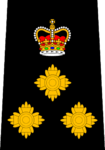 |
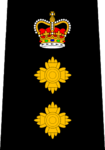 |
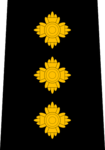 |
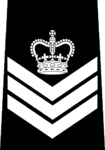 |
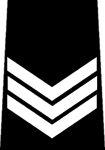 |
 |
No insignia |
Training
As of 2005, newly hired officers must complete the Police Recruit Training Program through the Centre for Advancement in Community Justice, located at the Lethbridge College.
Structure
The organization of the police service includes four divisions: community policing, criminal investigation, administrative support and support services.
Community policing
The community policing division is mandated to maintain the peace, protect life and property, and the prevention and detection of crime. It is composed of the following units:
- Patrol services
- Downtown policing
- Traffic safety
- Court liaison
- Community resource
- Victim services
Criminal investigation
The criminal investigation division provides support services to ongoing investigations through the dissemination of intelligence and investigation assistance. Units in the division include:
- Violent crime
- Forensic identification
- Crime analysis
- Property crime
- Serious habitual offenders
- Special operations
- Criminal intelligence
- Economic crime
- National weapons enforcement
- Gaming and liquor enforcement
Administrative support
The administrative support division oversees the following areas:
- Human resources
- Professional standards
- Policy and accreditation
- Property and exhibits
- Business management
Support services
The support services division provides support to all other divisions as required, including a specialized response to ongoing crises and ensuring the continuous flow of information. This division includes:
- Public safety communications
- Information technology
- Records management
- Tactical unit
- Canine unit
- Explosive disposal unit
Fleet
Patrol
- Ford Taurus Police Interceptor Marked and Unmarked
- Ford Crown Victoria Police Interceptor
- Ford F-150 Pickup Truck
- Ram 1500 Pickup Truck (marked and stealth units)
- Chevrolet Silverado Pickup Truck
- Dodge Charger New addition in 2019
- Ford Transit van (downtown policing unit)
Traffic and photo radar
- Ram 1500 pursuit pickup truck
- Chevrolet Silverado pickup truck
- Ford F-150 pickup truck
- Buick Enclave SUV
- Dodge Grand Caravan
- Victory Commander I motorcycle
Special use
- GMC Yukon (supervisor)
- Chevrolet Impala (school resource officers)
- Dodge Grand Caravan (forensics)
- Ford Transit van (forensics)
- Chevrolet Tahoe Marked and Stealth (canine)
Equipment
Officers are equipped with SIG Sauer P226 pistols in .40 S&W. In 2019, Lethbridge Police Service purchased Glock 17 Gen 5's in 9mm to replace the P226. Currently, members can choose one or the other to carry on duty.
References
- White, Ryan (14 July 2020). "Lethbridge police officers demoted for tracking Alberta minister over park plans". CTV News. Retrieved 15 July 2020.
- "2006–2008 Business Plan" (PDF). Lethbridge Police. Archived from the original (PDF) on 16 March 2007. Retrieved 4 January 2017.
- https://www.lethbridgepolice.ca/sites/default/files/2017-Annual-Report.pdf